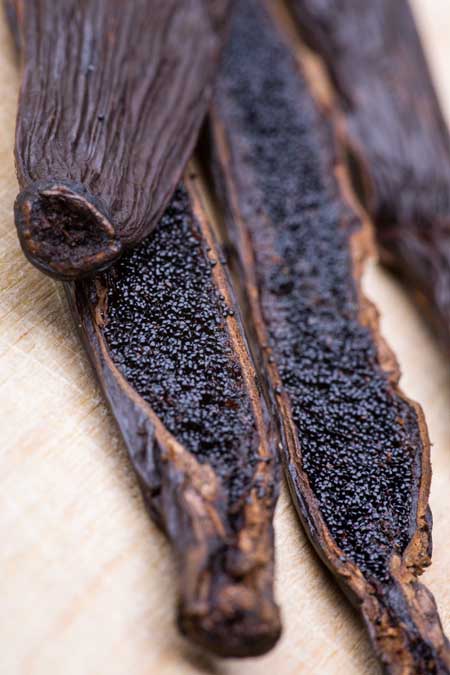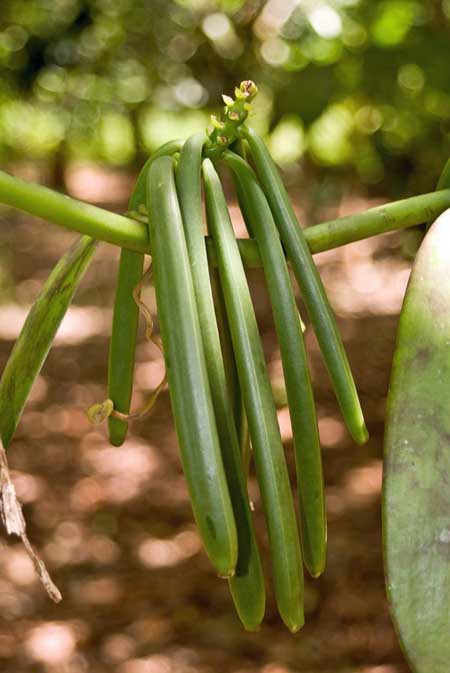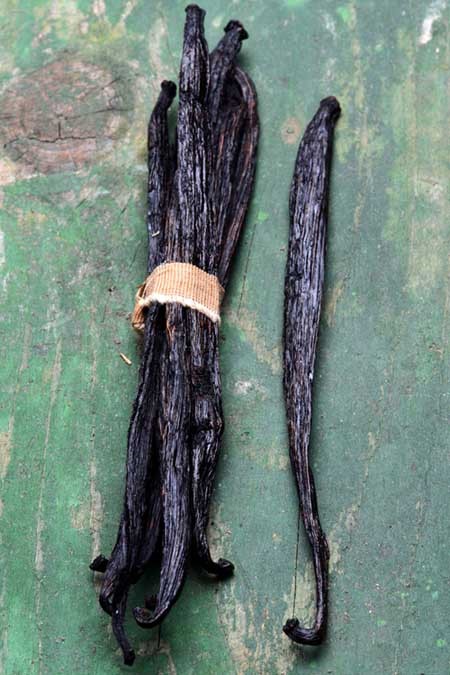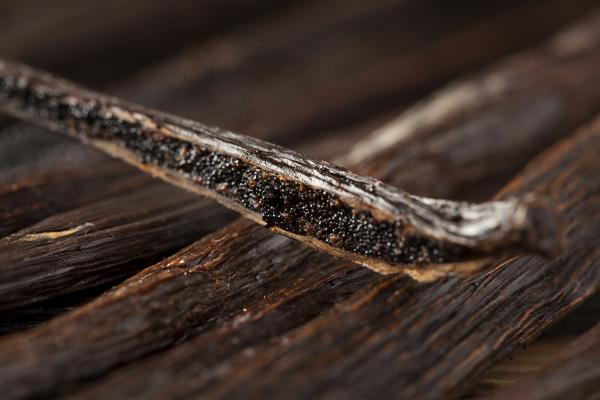Wikipedia tells us that the Aztecs acquired the vanilla discovery from the Totonac people. The Aztecs drank their chocolatl with a dash of vanilla, and Europeans, once they got used to the stuff (one appalled Spaniard described chocolate as “a drink for pigs”), followed suit.
Spanish conquistador Hernán Cortés is credited with 'acquiring' it in turn, and introducing both vanilla and chocolate to Europe in the 1520s.

Vanilla was thought of as nothing more than an additive for chocolate until the early 17th Century, when Hugh Morgan-a creative apothecary in the employ of Queen Elizabeth I invented chocolate-free, all-vanilla-flavored sweetmeats. The Queen adored them. By the next century, the French were using vanilla to flavour ice cream - a treat discovered by Thomas Jefferson in the 1780s, when he lived in Paris as American Minister to France. He was so thrilled with it that he copied down a recipe, now preserved in the Library of Congress. [Source: National Geographic]
The vanilla “beans” or pods are the actual seed capsules of an exotic species of a tree-climbing orchid. The Spanish called it vainilla, or "little pod". Vainilla is from the diminutive of vaina, from the Latin vagina (sheath) to describe the shape of the pods. Yum indeed!
(Okay so after image search for 'vanilla pod', I'm not sure what was wrong with the Spanish/Portugese women back then.... let's abandon this train of thought and get back to....}
... Magascar! which benefited from the ca. 1841 discovery by Edmond Albius' (from the Island of islands of Réunion previously Île Bourbon) that the vanilla plants could be pollinated by hand.
Orchids are fussy plants that typically do not self-pollinate - and the ability to hand-polinate made production feasible.
Madagascar, followed by Indonesia, are currently the largest producers of vanilla. Madagascar - yes, the home of zoboomafoo!
Foodal.com: Vanilla production takes an enormous amount of time and patience. The “beans” or pods are the actual seed capsules of an exotic species of a tree-climbing orchid.

Before the beans achieve their familiar black and wrinkled appearance, they must first pass through a long process of growth, pollination, and fermentation.
It takes four years for the orchid to bear its first fruit. Shortly before the blooming period (which is limited to mid-morning for just a few weeks) the green, unripe pods are picked.
This happens approximately months after pollination. And it doesn’t take place naturally – the fruits have to be pollinated by hand (except in Mexico by a local species of the Melipona bee).
The process of drying and fermentation that follows can take up to several weeks. During this time, the pods shrink and take on the blackish-brown color that we are familiar with.
By the latter half of the 19th century, the demand for vanilla skyrocketed. Not only was it the established flavor of choice for ice cream, but it was an essential ingredient of soft drinks-among these Atlanta chemist John S. Pemberton’s Coca-Cola, which went on sale in 1886, impressively advertised as an “esteemed Brain tonic and Intellectual Beverage.”
There are at least three varieties of real vanilla:
- Bourbon vanilla or Bourbon-Madagascar vanilla made from V. planifolia plants
- Tahitian vanilla made with V. tahitensis which is a hybrid
- West Indian vanilla is made from V. pompona
Vanilla extract is made by macerating and percolating chopped vanilla beans in alcohol and water for about 48 hours, after which the liquid is aged for several months and then filtered to achieve a clear, very fragrant amber liquid. There are double and triple strength vanilla extracts and they are not the same as the cheap and nasty vanilla essence which is disgusting. The essence is a liquid made from artificial flavoring and chemicals. [Source: Nonnabox]
The problem with vanilla is that it’s pricey. Vanilla is the second most expensive spice in the world (after saffron) because its production is so labor-intensive. Which is why a lot of products use the synthetic flavouring vanillin which is 20 times cheaper.

When used as part of beer brewing; vanilla beans or liquid vanilla extract is added either at the end of the boil during the whirlpool stage before wort is transferred for fermentation or post-fermentation before packaging. Whole beans can be used to “dry spice” the beer in the fermenter in a technique similar to dry hopping. Whole vanilla beans can also be added to a firkin or a pin to flavor a beer during cask conditioning.. [Source: Beer & Brewing]
"The Brewing" says you can use either vanilla extract or the actual beans for your beer but cautions you to avoid 'fake' vanilla extract: "The fake vanilla extract has a bitter aftertaste and won’t add that delicious flavor you’re expecting. "

So for beer, the vanilla better be the real deal!
Some great beers to look for are the Speedway Stout with Madagascar Vanilla, and highly recommended: picking up a growler of Storm Brewing's "Whiskey Vanilla Stout" a long-time favourite. We've tried the version in the can though, and that was actually not good! Beer Advocate has a page for 'Best Vanilla Beers' for some more suggestions.
As The Whole Portion asks 'How much vanilla can you put in Stout?' Apparently you can soak 2 vanilla beans in around 200ml of white rum (while the stout is fermenting) and then add it at bottling to a 23L (5.5 US gallon) batch. It will give a nice taste to the whole batch.
Well, there we go - vanilla and beer: a great combination. Also check out: Peanut butter and beer. Because obviously!
Feature photo from https://www.kqed.org/bayareabites/86884/real-vanilla-isnt-plain-it-depends-on-dare-we-say-it-terroir, credit Brent Hofacker/iStockphoto


Add new comment